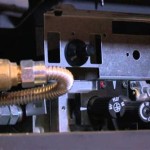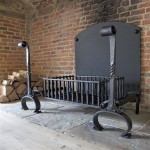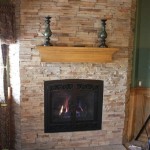Stainless Steel Fireplace Surrounds: Elegance, Durability, and Modern Design
Stainless steel fireplace surrounds have emerged as a popular choice for homeowners and designers seeking a blend of modern aesthetics, durability, and ease of maintenance. This material’s versatility allows it to complement various architectural styles, from contemporary minimalist to industrial chic. Beyond its visual appeal, stainless steel offers practical benefits that contribute to the longevity and safety of a fireplace. This article will explore the characteristics, advantages, and installation considerations associated with stainless steel fireplace surrounds.
Understanding the Properties of Stainless Steel
Stainless steel is an alloy of iron, chromium, and other elements such as nickel, molybdenum, and titanium. The presence of chromium is crucial, as it forms a passive layer of chromium oxide on the surface of the steel. This layer is self-healing, meaning that if the surface is scratched or damaged, the chromium oxide layer reforms, preventing further corrosion. This corrosion resistance is the defining characteristic of stainless steel and contributes significantly to its longevity, especially in environments exposed to moisture and heat. The specific grade of stainless steel chosen for a fireplace surround impacts its performance and cost. For fireplace applications, grades 304 and 316 are commonly used. Grade 304 offers good corrosion resistance and is suitable for most indoor environments. Grade 316 contains molybdenum, providing enhanced resistance to chlorides and making it a better choice for coastal areas or environments with high humidity.
The thickness of the stainless steel sheet also plays a significant role in its durability and heat resistance. Thicker gauges of stainless steel are better able to withstand the high temperatures generated by a fireplace without warping or buckling. A typical range for fireplace surrounds is between 16 and 18 gauge, but this can vary depending on the size and design of the surround.
Furthermore, stainless steel possesses excellent thermal conductivity, meaning it efficiently transfers heat. While this can be an advantage in some applications, in the context of a fireplace surround, it's essential to design the surround so that excessive heat transfer doesn't pose a risk to surrounding materials or individuals. Proper insulation and ventilation can help mitigate potential issues related to thermal conductivity.
Advantages of Choosing Stainless Steel for Fireplace Surrounds
There are several compelling reasons to opt for a stainless steel fireplace surround. Its inherent durability, aesthetic versatility, and ease of maintenance make it a desirable choice for a wide range of homeowners. Its resistant to corrosion and oxidation, unlike many other materials, making it a long lasting option for your fireplace.
One of the primary advantages is its resistance to heat and corrosion. Fireplaces generate significant heat, and traditional materials like wood can warp or crack over time. Stainless steel, however, can withstand high temperatures without degrading. The chromium oxide layer provides excellent protection against corrosion, preventing rust and ensuring the surround maintains its appearance even after years of use. This resistance is especially important in climates with high humidity or near coastal regions where salt air can accelerate corrosion in other materials.
Stainless steel offers exceptional design flexibility. It can be fabricated into a variety of shapes and sizes, allowing for customized designs that perfectly complement the surrounding decor. From sleek, minimalist surrounds to more intricate, decorative pieces, stainless steel can be tailored to meet specific aesthetic preferences. The smooth, reflective surface of stainless steel also enhances the visual appeal of the fireplace, adding a touch of modernity and sophistication to the room.
Maintaining a stainless steel fireplace surround is relatively simple. The smooth, non-porous surface resists staining and is easy to clean. Regular wiping with a damp cloth is usually sufficient to remove dust and fingerprints. For more stubborn stains, a mild detergent or stainless steel cleaner can be used. The material's resistance to bacteria and mold also makes it a hygienic choice for the home. Unlike materials like stone or brick, which can be challenging to clean and may harbor allergens, stainless steel provides a clean and sanitary surface.
Finally, stainless steel is a sustainable material. It is highly recyclable, meaning that at the end of its lifespan, it can be reused without significant loss of quality. This contributes to reduced waste and conservation of resources. The longevity of stainless steel also means that it doesn’t need replacement as frequently as other materials, furthering its environmental benefits.
Installation and Design Considerations
Proper installation is crucial to ensure the safety and longevity of a stainless steel fireplace surround. Careful planning and attention to detail are essential to avoid potential problems such as improper ventilation, inadequate heat protection, or structural instability.
The installation process typically begins with accurate measurements of the fireplace opening and surrounding area. These measurements are used to fabricate the stainless steel surround to the correct dimensions. It's important to consider the clearance requirements specified by the fireplace manufacturer to ensure proper ventilation and prevent overheating. Building codes may also dictate specific requirements for fireplace installations, and these must be adhered to.
When designing the stainless steel surround, consider the overall aesthetic of the room. Stainless steel can be polished to a high shine, brushed for a more subtle look, or even coated with a powder finish for a specific color. The choice of finish will impact the overall appearance of the fireplace and how it integrates with the surrounding decor. Additionally, consider the design of the surround itself. Simple, clean lines create a modern, minimalist look, while more elaborate designs can add a touch of elegance and sophistication. Consider adding features such as built-in shelves, mantels, or decorative accents to enhance the functionality and visual appeal of the fireplace.
Proper insulation is critical to prevent heat damage to surrounding walls and materials. Install a non-combustible material, usually cement board or a similar product, behind the stainless-steel surround to protect the wall. This insulation will also prevent heat from transferring to adjacent combustible materials, reducing the risk of fire. Consult with a qualified fireplace installer to determine the appropriate type and thickness of insulation for your specific application.
Securely attaching the stainless-steel surround to the fireplace is essential for safety and stability. Use appropriate fasteners, such as screws or bolts, to attach the surround to the fireplace structure. Ensure that the fasteners are compatible with both the stainless-steel surround and the underlying material. For larger or more complex surrounds, consider using a support structure to provide additional stability and prevent sagging.
Consider the surrounding materials when designing and installing a stainless-steel fireplace surround. Combining stainless steel with natural elements such as wood or stone can create a visually appealing contrast. However, it's essential to ensure that these materials are properly protected from heat and moisture. Seal wood surfaces to prevent warping or cracking, and use non-combustible grout for stone or tile installations.
Finally, inspect the installation thoroughly after completion to ensure that everything is properly aligned and secured. Check for any gaps or openings that could allow heat to escape or moisture to penetrate. If any issues are identified, address them promptly to prevent potential problems in the future. Consider scheduling a professional inspection to ensure that the fireplace installation meets all safety codes and regulations.
In addition to these considerations, it is beneficial to be aware of different types of stainless steel finishes available and how they can affect the final appearance of the surround. Brushed finishes, for example, offer a more muted and less reflective look compared to polished finishes. Powder-coated stainless steel can provide a range of color options, allowing for greater customization. The selection of finish should be based on the desired aesthetic and the overall design of the room.
Another key aspect to consider is the long-term maintenance of the stainless-steel surround. While stainless steel is generally easy to maintain, regular cleaning and occasional polishing may be required to keep it looking its best. Use appropriate cleaning products that are specifically designed for stainless steel to avoid damaging the surface. Avoid using abrasive cleaners or scouring pads, as these can scratch the surface and detract from its appearance.
Furthermore, when choosing a stainless-steel fireplace surround, consider the expertise of the manufacturer or installer. Experienced professionals will have the knowledge and skills to fabricate and install the surround correctly, ensuring that it meets all safety requirements and provides optimal performance. They can also offer valuable advice on design options, material selection, and maintenance procedures.
By carefully considering these installation and design considerations, homeowners can ensure that their stainless-steel fireplace surround not only enhances the aesthetic appeal of their living space but also provides years of safe and reliable performance. A well-designed and properly installed fireplace can become a focal point of the home, providing warmth and ambiance for years to come.
Steel Fireplace Surround S By Kramer Design Studio Randall Wescover Fireplaces

Stainless Steel Fireplace Surround Photos Ideas Houzz

A Blackened Steel Fireplace Surround With Concrete Hearth Is Strong Look Inside This Mid Century Modern House

3 Sided Fireplace Surround Kit In Brushed Stainless Steel

Aluminum Or Stainless Steel Fireplace Surrounds Custom Frames For Fireplaces

Leo Gaev Metalworks Fireplace Surround Metal Remodel Surrounds

Volcanic Stainless Steel Fireplace Surround Contemporary Family Room Portland By Milo S Art Metal Llc Houzz

Custom Fireplace Design Build

42 Steel Surrounds Ideas Fireplace Design House

N Springs Fireplace Surround Brandner Design
Related Posts








